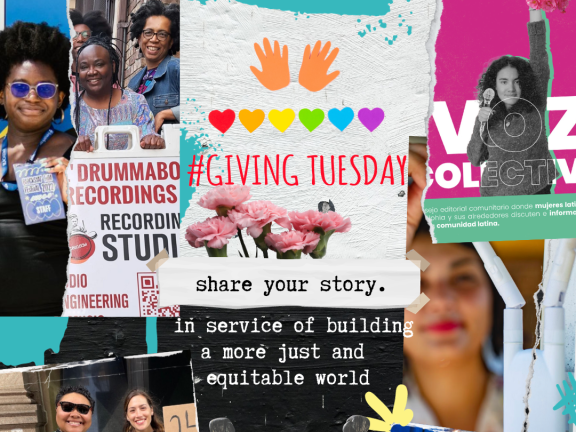A Guide for a Successful GivingTuesday

Giving Tuesday is a day dedicated to generosity, occurring right after Thanksgiving. It began in 2012 as a response to the hypercapitalism and individualism that often characterize the holiday season and the entire year, fueled by advertising and social media. In contrast, Giving Tuesday aims to uplift generosity and leverage social media’s power to encourage charity, community building, and volunteering.
Understanding the history of what has evolved into a global movement can help shape your "why" for participating in Giving Tuesday. How would you like to encourage your community to express and participate in the spirit of the season's gratitude? How can your Giving Tuesday campaign inspire your supporters to help build a more just and equitable world, especially in challenging times? Additionally, how can you promote philanthropy (love of humanity) in an era marked by increasing misanthropy (dislike of humankind)?
Giving Tuesday also signals the beginning of the end-of-year fundraising season for nonprofits. People are generally more inclined to give during the holiday season, making it an ideal time to ask for support. Here are some tips for a successful and impactful Giving Tuesday campaign:
Before GivingTuesday
Creating Your Plan
- Preparation is key before December 2 (the date for GivingTuesday 2025). People appreciate a personal connection, and cold requests for donations are often ineffective. So starting your efforts sooner rather than later can set the stage for better outcomes on this important day.
- With about one month left, spend this time strengthening your relationships with your supporters. Engage them with your organization’s work or project focus and prepare them for a call to action. Be open about how they help you keep doing great things or what you need to kickstart your next big project.
Telling Your Story Through the Appropriate Communication Channels
- Start crafting your campaign messages early. Which moments this year were you excited to share with your communities? This year was challenging for so many people, so be honest about the challenges you faced, how you overcame them, or how you need your community to rally around you to help you tackle those challenges.
- Use the art of storytelling and compelling images to remind your audience why they support you and let them know how they can cheer you on. You can use free tools like Canva to jazz up your stories with eye-catching graphics—for inspiration, check out the GivingTuesday Campaign's library of Canva Templates.
- Get creative with your calls-to-action by sharing actions that feel doable or bring joy into the world. Not every call-to-action has to be “donate now.” You can invite folks to share your campaign, forward the email, or post why they love your organization and encourage their networks to give. The key is to make the next step feel easy and enjoyable. When taking action is simple, your supporters are more likely to follow through and feel good about participating.
- Select communication channels that will work best for your goals. For instance, if you want to reach working professionals, LinkedIn is a great way to engage them. If most of your donors are 18 to 30, it might be best to use platforms like TikTok, Threads, Snapchat, and Instagram to reach them. Also, explore using text messages and text-to-give options. Text messages are almost always read, and can be used to ask for donations, remind people about upcoming events (i.e., your GivingTuesday campaign), or get people to take action.
- Remember, sending too many reminders could quickly feel like spam. Keep emails and texts to a minimum so you don't annoy your supporters and get blocked before GivingTuesday.
- Figure out who your supporters are and benchmark how much they might be able to give based on their demographic information. Then set your fundraising goals based on this information.For example, if most of your supporters are primarily college students or young professionals, aiming for $500 might be a reachable goal (they may give in $5, $10, etc). If your supporters are established working professionals in the 45 to 65 age range, perhaps it's more feasible to aim for higher fundraising goals.
- You don't have to keep your fundraising goal to yourself. Sharing your goal with your supporters can be part of your GivingTuesday campaign strategy. It transforms the goal into a fun group challenge that helps your supporters feel like they're part of something big and creates a sense of being part of a shared win when it's accomplished.

Delegating Within Your Network
- Determine which members of your team will handle specific tasks on the day of the event. Assign roles such as who will be posting on social media, who will monitor your progress, who will send emails, and who will be responsible for sending out those important Thank Yous (I’ll provide more details on this later!).
- Make sure your board is engaged in the planning process leading up to GivingTuesday. Encourage them to share stories from their networks by creating social media posts that they can distribute through their own channels. Additionally, board giving can significantly contribute to your fundraising efforts. If you feel comfortable, you can ask your board members to contribute to the campaign to the best of their ability (it’s best not to set specific dollar amounts since everyone’s capacity to give varies).
Preparing for Payments
- Check your payment channels to ensure everything will work well for your donors. Donate to your own nonprofit/project to check that the thank you page (if you have one) and the follow-up email are updated and designed to show any next steps (i.e., sharing the campaign within their networks) you may want supporters to take.
- If you haven’t already, explore adding options for digital wallets (like Apple Pay) and recurring payments, which can make payments more convenient.

On GivingTuesday
- If you've done a lot of prep work beforehand, on GivingTuesday, focus on engaging your audience on social media and thanking them for their support. You can send mini-updates throughout the day to motivate folks to join the giving. Be careful not to spam people via email and text.
- Always thank your donors after each donation. You can do this through an email or by using ThankView, a platform that allows nonprofits to send personalized thank-you videos to donors. Alternatively, you can send thank-you notes by mail.
- You can choose how to express your gratitude based on the amount each donor contributed:
- For instance, you might send a thank-you email for a $10 donation, send an email along with a mailed thank-you card for a $50 donation, and send both an email and a ThankView video for a $100 donation.
- Overall, it's essential to ensure that there is an immediate email thank-you for each donation. Taking a more personal approach can help retain and strengthen donor relationships.
After GivingTuesday
- Reflect on how it went. What went well? What would you change? What do you want to do again next year? Which new or current donors would you like to get to know better?
Remember, GivingTuesday is not just about raising funds. It’s also a time to share your organization/project’s stories and invite your communities to celebrate and be inspired to action.

